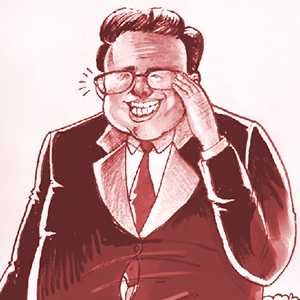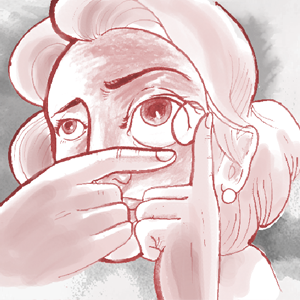From athletes to non-native speakers, eyecare pros across the country are driving business performance by finding niche demographics.
Sometimes a clear path to capturing new business sits in plain view. A patient with limited English struggling to communicate during an appointment. A big-and-tall man seeking large frames. A basketball-crazed teen in need of prescription eyewear on the hardwood. Recognizing the needs of these patient groups and other often-underserved segments of American society and then addressing their needs with equal doses of strategy and sincerity can help an optical business earn new customers, deepen its marketplace penetration and boost financial performance.
Here are five optical businesses that discuss how they spotted a niche group and then crafted a plan to cater to that demographic in practical, profitable ways.
By Daniel P. Smith

Advertisement
THE BIG GUYS
“We’re in an area that’s highly Scandinavian, so there are a lot of big dudes around,” says Nikki Griffin, owner of EyeStyles Optical and Boutique in Oakdale, MN.
About a year ago, one such man of larger proportions walked into EyeStyles and handed Griffin a pair of broken frames. He asked Griffin if she could score him a replacement, noting that his doctor’s office had stopped carrying larger frames. As Griffin researched options for that individual and also reflected on the local market need, it became clear that “big dudes” and their female counterparts failed to earn much legitimate attention.
“There’s nothing out there and you know there’s a market for it, so you say, ‘Why don’t we become the destination? Big guys go to big-and-tall stores for clothing, so let’s become their place for eyewear,’” Griffin says.
In February 2016, Griffin began bringing that vision to life.
She commissioned a custom-made, 4-foot display board featuring frames for men sized 58-65 and women sized 56 and up. Constructed out of pallet wood with pipe flanges holding acrylic frame rods, the merchandising display features a playful graphic of Paul Bunyan and his beloved ox, Babe. The fun, lighthearted visual pays homage to northern folklore well known in EyeStyles’ parts, but also helps the optical shop build a story around its niche efforts.
Advertisement
The “Paul and Babe Board” presents 80 frame options from the likes of Etnia Barcelona, Fatheadz and Modern Optical’s B.M.E.C. line. The deep selection is a significant departure from the handful of large frames most optical shops carry and has helped EyeStyles gain marketplace traction.
“These people who need bigger frames now don’t have to settle. They can find what they need with us,” says Griffin, who is opening a new, larger EyeStyles location in Oakdale this fall in which the “Paul and Babe Board” will be featured prominently.

Nikki Griffin
EyeStyles Optical and Boutique, Oakdale, MN
Ramp up Your Business with the Big Guys
➜ Before Griffin invested in a single pair of big frames, she first investigated the available inventory from manufacturers and assessed the opportunity to make a full, compelling collection. “If you can’t make a collection out of it, then it’s just weak,” she says.
➜ Most “big guy” glasses are of the traditional variety, but Griffin worked to push her selection beyond convention, a mindset characterized by a number of fashion-forward looks from Etnia Barcelona. “Big guys want fashionable eyewear, too,” she says.
➜ One notable observation Griffin’s made of “big guy” customers: “This particular market isn’t big into plastic frames. They prefer metal.”
Advertisement

THE UNINSURED (OR THE UNDERINSURED)
At EyeShop Optical Center, a 5-year-old operation located on the northern outskirts of Columbus, OH, Dr. Cynthia Sayers noticed an escalating number of self-pay patients and families without any vision coverage.
“It wasn’t necessarily that these patients couldn’t afford vision coverage, but rather that employers simply weren’t offering vision coverage as an option,” Sayers says.
That reality bothered Sayers, who began contemplating potential solutions capable of benefiting patients and her practice.
“Instead of losing these people, I said, ‘Let’s find a way to make it more affordable for them,’” Sayers says.
The result?
The EyeTeam, an exclusive EyeShop membership program in which patients pay an annual fee — $25 for individuals and $40 for families — in return for discounts throughout the year on contacts, glasses and exams.
“It’s kind of like our own little insurance plan,” Sayers says.
Consider an individual walking off the street into EyeShop, where a comprehensive eye exam runs $120. If that individual joins the program for $25 and then pays the discounted $60 exam rate, he or she is immediately ahead of the game $35 compared to paying out of pocket. Thereafter, the individual receives such dollar-saving benefits as: a 10 percent discount on contact lens materials; 30 percent off the individual’s first complete eyewear; and a 30 percent markdown on non-prescription sunglasses.
For families paying $40, the savings only multiply.
“That’s where the benefits of this program really kick in,” Sayers says.
Since debuting in February, Sayers says the novel membership program has helped EyeShop, which has about 5,000 individuals in its system, retain patients and drive new patient acquisition as well.
“New clients are much more likely to bite when they find out about the membership program,” Sayers says, adding that the program has also increased EyeShop’s profitability as well as the number of self-pay patients it sees. “The uninsured person is truly shopping around and the EyeTeam membership gives them a reason to visit us. When we explain what the program entails, it’s rare we have someone turn it down.”

Dr. Cynthia Sayers
EyeShop Optical Center, Columbus, OH
Ramp up Your Business with the Uninsured
➜ Anytime a patient — new or existing — calls EyeShop, staff tout the membership program. “We want everyone we are in contact with to be aware of the opportunity because we know just how advantageous it is and that it’s an attractive point of differentiation for our business,” Sayers says.
➜ EyeShop’s local outreach includes visiting local businesses that do not offer vision insurance and delivering EyeTeam membership program literature to spur awareness and visits.
➜ Sayers and her team remind clients that their membership benefits cover the entire year. Planting that seed, Sayers notes, sparks repeat traffic and purchases.
➜ With the EyeTeam program in place, EyeShop has been able to retain patients motivated to visit only after purchasing a Groupon deal. While Groupon-inspired visits typically result in a one-time interaction, Sayers says offering the EyeTeam membership has served an attractive bounce-back that has fueled ongoing relationships.

THE SPECIALTY CONTACT LENS MARKET
Within a half-mile radius of The Gardens Eye Care, Dr. Rita Ellent’s 2-year-old office in the Forest Hills neighborhood of Queens, NY, sit more than a dozen optical businesses selling eyewear and vision services.
“To say it’s competitive,” Ellent says, “is a drastic understatement.”
Differentiation is the name of the game and something Ellent has developed at The Gardens by dishing out custom-made specialty contacts.
“I saw patients coming in with all kinds of vision issues impacting their personal and professional lives, and as I saw more and more of these patients, it just clicked that this was my niche,” Ellent says.
Earlier this year, Ellent began expanding her practice deeper into specialty contact lenses, eschewing generic soft contact lenses for custom-made solutions tailor made to address a patient’s specific needs and condition.
“I compare it to a custom-made suit rather than one you buy off the rack: Everything is tailored specifically to the individual,” Ellent says, adding that the specialty contacts she has provided patients have spurred significant improvements in quality of life.
“In that way, it’s wonderful to know you’re truly making a difference,” she says.
Though these patients require significant chair time and, at times, handholding, Ellent’s efforts to address their vision problems have propelled the performance of her young practice. The patients, pleased with Ellent’s involved work after years of struggling with other contact lens modalities, have become active cheerleaders for her practice and refer new patients to her office.
“It’s been a fantastic avenue to pursue and dive into,” Ellent says, calling specialty contact lenses both financially profitable and a significant growth opportunity for The Gardens.
And as an added benefit, the specialty work has also energized Ellent professionally.
“From the clinical perspective, I’m seeing a diverse range of cases that’s keeping things interesting and broadening my knowledge,” she says.

Dr. Rita Ellent
The Gardens Eye Care, Queens, NY
Ramp up Your Business with the Specialty Contact Lens Market
➜ While Ellent has invested in technology to help her practice, including the recent purchase of a corneal topographer, she considers human relations central to serving patients with unique needs. “The key as a doctor is always listening to patients and understanding their needs and challenges, and this is even more true when the patients present a case that is not run of the mill,” she says.
➜ Ellent continues personally meeting with local ophthalmologists as well as cornea and retina specialists to build a referral network, which she calls “a successful strategy” thus far.
➜ For those looking to break into the specialty contact lens niche, Ellent suggests attending any industry meetings or lectures geared toward these niche markets. “Network, ask questions and use others’ experiences as a learning curve rather than relying solely on your own trial and error,” she says.

THE NON-ENGLISH SPEAKERS
Dr. Texas Smith proves an old doc can learn new tricks. At age 73 and in his 51st year of practice, the high-spirited Smith recently completed his second semester of conversational Spanish at Sacramento City College. Smith didn’t make the effort — two nights each week for the entire academic year — to scratch some longstanding intellectual itch, but rather to better serve patients at his namesake office in Citrus Heights, CA.
“These are my patients and if I can do things to help them feel more comfortable during their visit, then I’m going to do that,” Smith says.
In Citrus Heights, where the U.S. Census reports that one in five residents speak a language other than English at home, Smith calls returning to the classroom for conversational Spanish — the area’s dominant non-English language — a wise move, even if Spanish speakers represent fewer than 10 percent of his patient roster.
“Rarely a day goes by that I don’t encounter a Spanish-speaking patient,” he says.
Though Smith’s academic efforts have not necessarily generated a more robust bottom line for his practice or produced a flood of new patients, it has undoubtedly endeared him to the Spanish-speaking patients he does see and also served to streamline appointments.
“You’re not necessarily doing it to get more patients, but to make things more efficient, effective and comfortable for the patients you have while they are present,” he says. “When patients see I’m trying to communicate with them on their level, they become so much more relaxed and that helps everything move along better.”
Smith often jokes with his Spanish-speaking clientele that he will work on his Spanish as best he can during their appointment if they promise to work on their English as best they can.
“They appreciate my effort and it puts them at ease, which is a big part of the battle we face as doctors,” Smith says.

Dr. Texas Smith
Dr. Texas Smith, Citrus Heights, CA
Ramp up Your Business with Non-Native Speakers
➜ The easiest way to accommodate non-native speakers, Smith says, is to hire an employee fluent in the area’s most prominent foreign language, whether that is Spanish, Polish, Mandarin or another tongue. “People are always more comfortable speaking in their native language and if that’s something you can offer patients, they’ll certainly appreciate it and remember it,” he says.
➜ Smith suggests doctors and optical staff leverage technology to guide a non-native speaker’s appointments in a more positive, productive direction. He specifically points to Google Translate, which provides translation between English and more than 100 other languages. “At the minimum, you can pull up Google Translate on a tablet and have that by you when you’re serving non-English speakers,” Smith says.

THE ATHLETES
At Wilson Eye Center, a 35-year-old practice in Valdosta, GA, staff consistently noted how few bespectacled children wore eyewear during soccer, basketball and other athletic endeavors.
“Parents often thought it was good enough that their kids were in glasses at all,” Wilson Eye Center optical manager Brenda Powers says.
Given that the vast majority of kids’ eye-related injuries derive from sports — as high as 90 percent by some estimates — the Wilson team looked to reverse that prevailing philosophy and attack its most pressing obstacle: cost.
In April, Wilson staffers traveled to Vision Expo East on a mission to find more economical sports frames.
Weeks later, the 9,700-square foot office unveiled a sports-specific display featuring 18 pieces of sports eyewear from Hilco. Flanked by sports paraphernalia and photos, the merchandising display showcases different styles, colors and customization options, including the ability to personalize frames with a school name or an athlete’s jersey number.
The line extension’s May debut helped staff get comfortable with the sports-specific product throughout the summer and also generated a degree of buzz with customers before Wilson Eye Care spotlighted the sports eyewear in its annual back-to-school promotion in August. In addition to its routine discount on children’s frames and lenses during the annual fall promotion, the practice offered sports eyewear with polycarbonate lenses and scratch coating for $135.
“Introducing the sports eyewear during the back-to-school season was such a natural fit,” Powers says.
While the early response to the sports eyewear has been steady at Wilson Eye Care, Powers believes the best is yet to come, especially as leadership has marked expanding the sports eyewear business a top priority in 2017.
“There’s no doubt parents are talking about it and that awareness is growing,” Powers says. “That along with the sheer number of kids playing sports makes us really optimistic moving forward.”

Brenda Powers
Wilson Eye Center, Valdosta, GA
Ramp up Your Business with Athletes
➜ In the months after the sports eyewear arrived at Wilson Eye Care, staff visited team practices and also distributed fliers showcasing the new eyewear to parents, especially those heading to a sports practice. Opticians, meanwhile, pointed out the new sports eyewear during children’s visits. “There are plenty of opportunities to highlight what we offer here and we need to take advantage of those,” Powers says.
➜ Moving forward, Wilson Eye Care will place a particularly high emphasis on education, noting how sports eyewear improves vision and protects athletes. Powers and her team will specifically look to develop personal relationships with coaches and also plan to visit athletic centers like the YMCA and Boys and Girls Club to promote the value of sports eyewear with well-placed influencers.